481. Bennett's Woodpecker Campethera bennettii (Bennettse Speg)
Order: Piciformes. Family: Picidae
Description
Size 22 to 24 cm. Weight 70 g. Small to medium-sized woodpecker with greenish back and a cream belly heavily spotted.
The male has a full red crown and broad moustachial stripes contrasting with plain face and throat.
The female has a brown throat and ear coverts and a black forehead flecked with white.
The Juvenile resembles female with chestnut throat and cheek and black forehead speckled with buff.
Similar species: Spotted, not streaked, underparts distinguish it from similar sized Golden-tailed Woodpecker and smaller Cardinal Woodpecker.
Distribution
From Tanzania south to Botswana, Zimbabwe, north central Namibia (central and northern Namibian areas such as Etosha National Park, Caprivi and Bwabwata National Park.), Mozambique and north-eastern South Africa.
Taxonomy
There are two subspecies:
C. b. bennettii, the eastern race, has creamy white to pale buff underparts with dark brown spots; and
C. b. capricorni from northern Namibia, northern Botswana, Angola and western Zambia has yellow underparts that are only weakly and finely spotted (appearing unmarked in the field).
Habitat
Broad-leaved woodland and savanna.
Diet
It feeds mostly on the ground mostly on ants, ant eggs and ant pupae. Excavates the surface of the ground for termites and underground ant nests, scooping them up with the sticky tongue.
Breeding
Monogamous and territorial. Pairs nest solitarily and are widely spaced. Nests in holes in trees, often using those excavated by other Woodpeckers (such as the Bearded woodpecker). Egg-laying season is from August-February, peaking from October-December. It lays 2-6 eggs, which are incubated by both sexes for 15-18 days. The chicks stay in the nest for 26-27 days, after which they remain dependent on their parents until the next breeding season.
Call
Characteristic loud ringing whirrr-itt-whrrr-itt, often in duet, repeated rapidly 6 to 8 times. More vocal than other woodpeckers in the region, but seldom drums Listen to Bird Call.
Status
Fairly common resident.
Africa Wild Bird Book
- nan
- Posts: 26478
- Joined: Thu May 31, 2012 9:41 pm
- Country: Switzerland
- Location: Central Europe
- Contact:
Bennett's Woodpecker Photos
481. Bennett's Woodpecker Campethera bennettii

Female
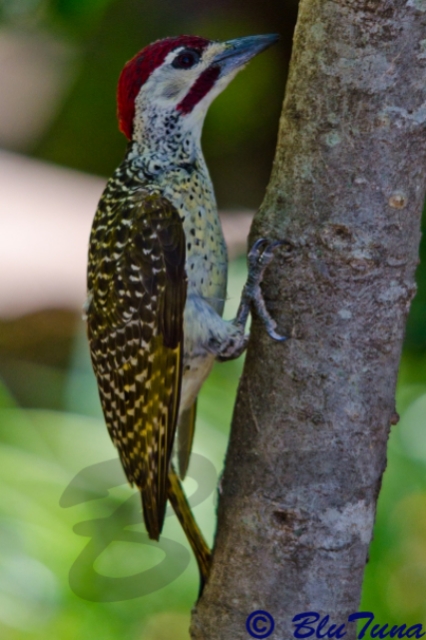 © BluTuna
© BluTuna
Male, Kruger National Park
 © Pumbaa
© Pumbaa
Female and male, Kruger National Park
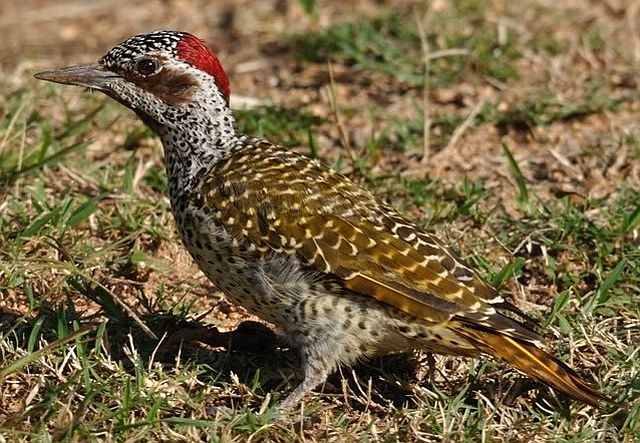 © BluTuna
© BluTuna
Female
 © pooky
© pooky
Male
 © pooky
© pooky
Male

Male
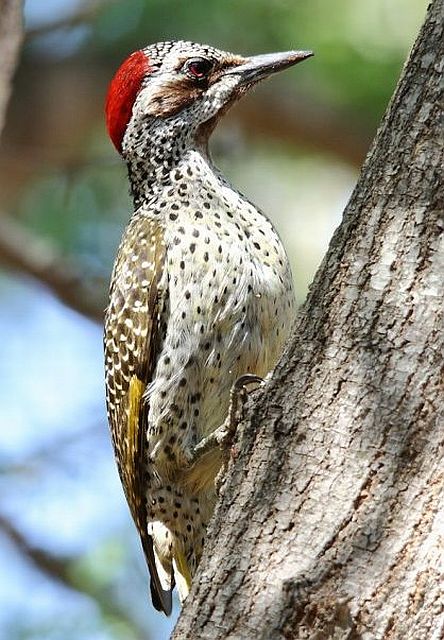 © Flutterby
© Flutterby
Female
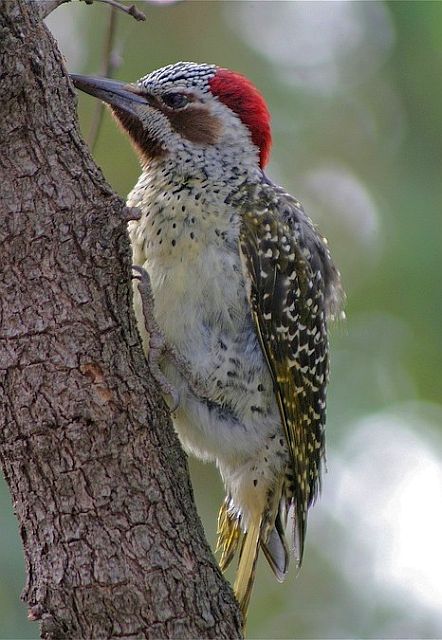 © ExFmem
© ExFmem
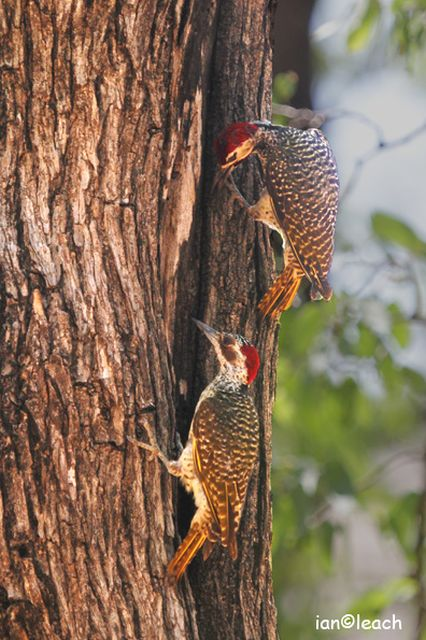 © leachy
© leachy
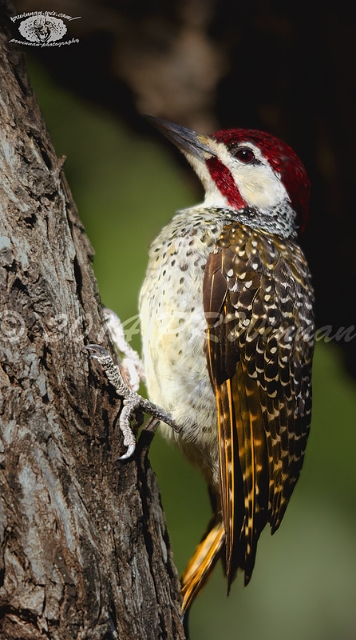 © PRWIN
© PRWIN
Male, Kruger National Park
Links:
Species text sabap1

Female
 © BluTuna
© BluTunaMale, Kruger National Park
 © Pumbaa
© PumbaaFemale and male, Kruger National Park
 © BluTuna
© BluTunaFemale
 © pooky
© pookyMale
 © pooky
© pookyMale

Male
 © Flutterby
© FlutterbyFemale
 © ExFmem
© ExFmem © leachy
© leachy © PRWIN
© PRWINMale, Kruger National Park
Links:
Species text sabap1
Kgalagadi lover… for ever
https://safrounet.piwigo.com/
https://safrounet.piwigo.com/
-
Michele Nel
- Posts: 1994
- Joined: Mon Sep 10, 2012 10:19 am
- Country: South Africa
- Location: Cape Town
- Contact:
Golden-tailed Woodpecker
483. Golden-tailed Woodpecker Campethera abingoni (Goudstertspeg)
Order: Piciformes. Family: Picidae
Description
Length 19-22 cm. Has streaked, rather than spotted, underparts.
Adult male: Forehead and crown grey-black, speckled crimson; nape crimson. Malar stripe dark red, with black showing through. Lores, supercilium and ear coverts creamy white, with fine black streaks on sides of face. Back, wings and rump yellowish green, spotted pale yellow (racially variable). Upper tail barred yellowish brown, shafts golden yellow. Chin and throat creamy white, streaked blackish. Remainder of underparts creamy white, grading to yellowish on belly and vent, heavily streaked blackish brown, most heavily on breast, forming gorget. Bill black, tongue long and sticky with viscous saliva. Eyes dark red-brown. Legs and feet greyish black.
Adult female: Crown and moustachial stripe black with white spots; nape red.
Similar species: Closely resembles Knysna Woodpecker in head and facial markings (male and female), but underparts streaked not blotched, and upper parts greener. Ranges overlap marginally in s KwaZulu-Natal and extreme e E Cape. Bennett's Woodpecker has spotted, not streaked underparts, male Cardinal Woodpecker has upper parts barred not spotted, and Little Spotted Woodpecker has underparts spotted, not streaked.
Distribution
Mainly occurs from Angola and Tanzania to South Africa, with isolated populations in East Africa. In southern Africa, it is fairly common in Zimbabwe, Mozambique, Botswana, parts of Namibia and north-eastern South Africa.
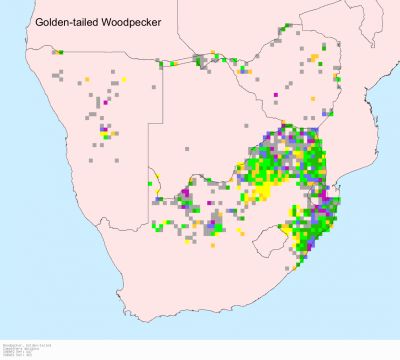
Habitat
It generally prefers riparian woodland, thickets, Miombo (Brachystegia), Mopane (Colosphermum mopane) and Burkea (Burkea africana) woodland.
Diet
Mainly forages in trees, tapping and probing branches in search of insects, then licking them up with its barbed tongue.
Breeding
Monogamous and territorial. Both sexes excavate the nest, which is usually a hole in the underside of a tree branch, occasionally used over multiple seasons. Egg-laying season is from August-December, peaking from September-November. It lays 2-3 eggs, which are incubated by both sexes for about 13 days. The chicks are cared for by both parents, eventually leaving the nest after about 22-25 days. They become fully independent a few weeks after fledging.
Parasitised by Scaly-throated Honeyguide, Greater Honeyguide and Lesser Honeyguide.
Call
The territorial call is a single, loud shriek wheeeeaa; similar to the sound of a nail being pulled from a plank. Call very similar to Knysna Woodpecker, but lower pitched.
Listen to Bird Call.
Status
Common resident.
Order: Piciformes. Family: Picidae
Description
Length 19-22 cm. Has streaked, rather than spotted, underparts.
Adult male: Forehead and crown grey-black, speckled crimson; nape crimson. Malar stripe dark red, with black showing through. Lores, supercilium and ear coverts creamy white, with fine black streaks on sides of face. Back, wings and rump yellowish green, spotted pale yellow (racially variable). Upper tail barred yellowish brown, shafts golden yellow. Chin and throat creamy white, streaked blackish. Remainder of underparts creamy white, grading to yellowish on belly and vent, heavily streaked blackish brown, most heavily on breast, forming gorget. Bill black, tongue long and sticky with viscous saliva. Eyes dark red-brown. Legs and feet greyish black.
Adult female: Crown and moustachial stripe black with white spots; nape red.
Similar species: Closely resembles Knysna Woodpecker in head and facial markings (male and female), but underparts streaked not blotched, and upper parts greener. Ranges overlap marginally in s KwaZulu-Natal and extreme e E Cape. Bennett's Woodpecker has spotted, not streaked underparts, male Cardinal Woodpecker has upper parts barred not spotted, and Little Spotted Woodpecker has underparts spotted, not streaked.
Distribution
Mainly occurs from Angola and Tanzania to South Africa, with isolated populations in East Africa. In southern Africa, it is fairly common in Zimbabwe, Mozambique, Botswana, parts of Namibia and north-eastern South Africa.

Habitat
It generally prefers riparian woodland, thickets, Miombo (Brachystegia), Mopane (Colosphermum mopane) and Burkea (Burkea africana) woodland.
Diet
Mainly forages in trees, tapping and probing branches in search of insects, then licking them up with its barbed tongue.
Breeding
Monogamous and territorial. Both sexes excavate the nest, which is usually a hole in the underside of a tree branch, occasionally used over multiple seasons. Egg-laying season is from August-December, peaking from September-November. It lays 2-3 eggs, which are incubated by both sexes for about 13 days. The chicks are cared for by both parents, eventually leaving the nest after about 22-25 days. They become fully independent a few weeks after fledging.
Parasitised by Scaly-throated Honeyguide, Greater Honeyguide and Lesser Honeyguide.
Call
The territorial call is a single, loud shriek wheeeeaa; similar to the sound of a nail being pulled from a plank. Call very similar to Knysna Woodpecker, but lower pitched.
Listen to Bird Call.
Status
Common resident.
-
Michele Nel
- Posts: 1994
- Joined: Mon Sep 10, 2012 10:19 am
- Country: South Africa
- Location: Cape Town
- Contact:
Golden-tailed Woodpecker Photos
483. Golden-tailed Woodpecker Campethera abingoni
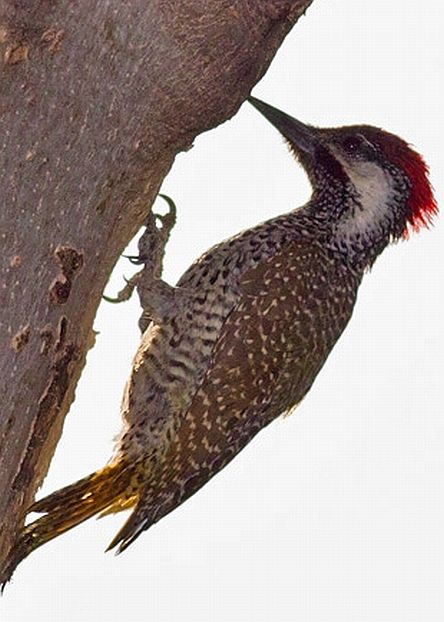 C. a. anderssoni
C. a. anderssoni
C. a. anderssoni is found in South-western Angola to Namibia, south-western Botswana and Northern Cape Province (of South Africa)
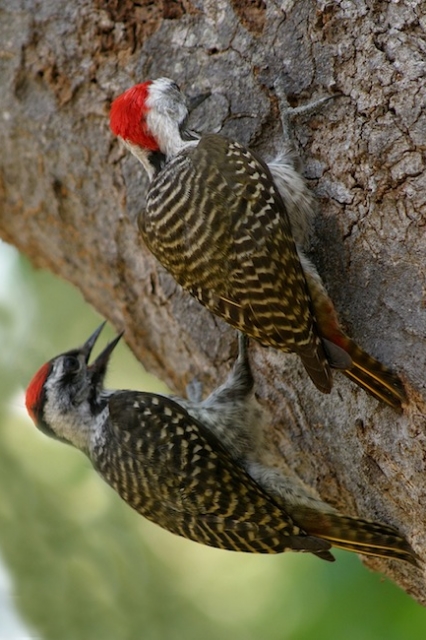 © ExFmem
© ExFmem
Kruger National Park
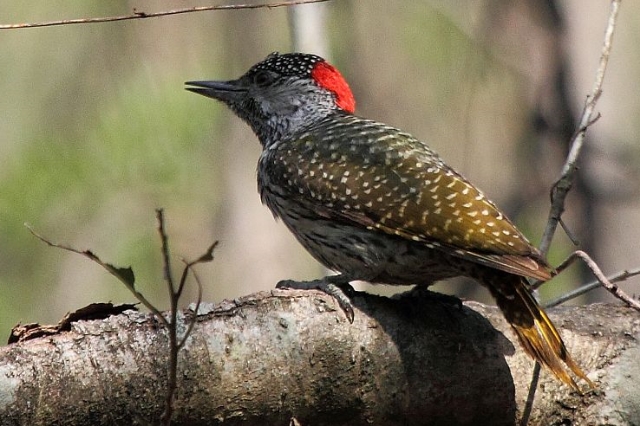 © Duke
© Duke
Walter Sisulu National Botanical Garden, Gauteng
 © Penga Ndlovu
© Penga Ndlovu
Female
 © harrys
© harrys
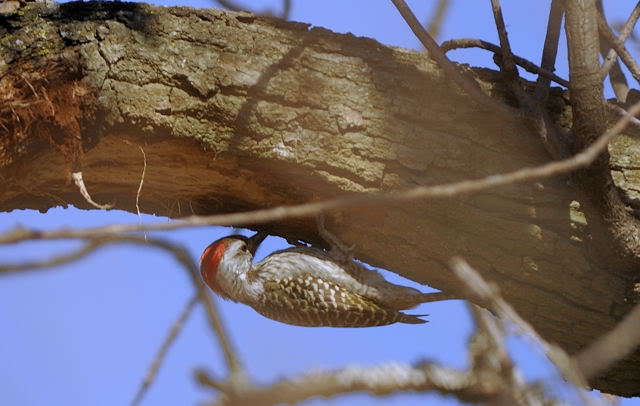 © Dewi
© Dewi
Rietvlei Nature Reserve, Gauteng
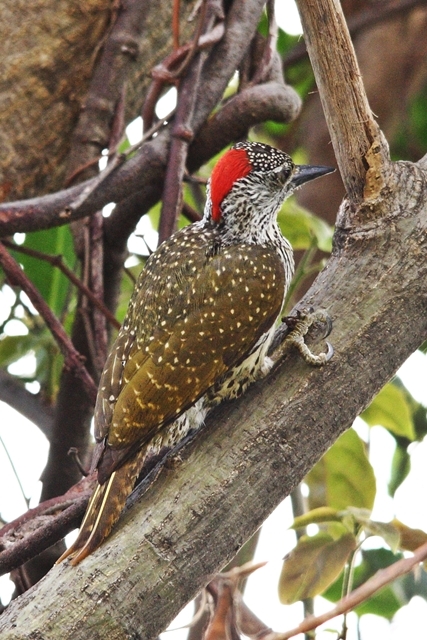 © Flutterby
© Flutterby
Margate, South Coast, KwaZulu-Natal
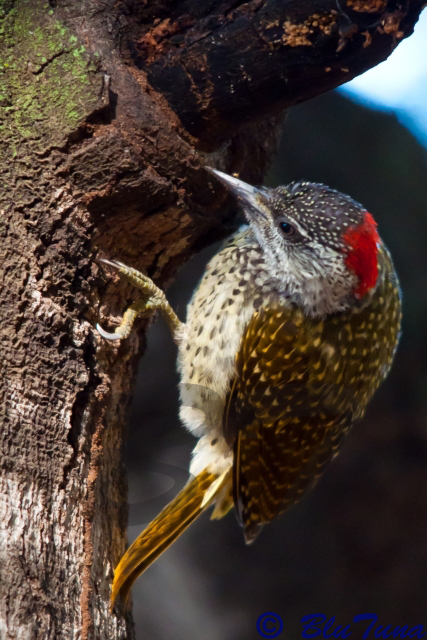 © BluTuna
© BluTuna
Kruger National Park
Links:
http://sabap2.adu.org.za/docs/sabap1/483.pdf
http://sabap2.adu.org.za/species_info.p ... #menu_left
http://www.biodiversityexplorer.org/bir ... ingoni.htm
NEWMAN'S VOELS VAN SA (8ste UIT)
Ian Sinclair. SASOL VOELS VAN SUIDER AFRICA (3de UIT)
Hans Winkler, David A. Christie: Woodpeckers
 C. a. anderssoni
C. a. anderssoniC. a. anderssoni is found in South-western Angola to Namibia, south-western Botswana and Northern Cape Province (of South Africa)
 © ExFmem
© ExFmemKruger National Park
 © Duke
© DukeWalter Sisulu National Botanical Garden, Gauteng
 © Penga Ndlovu
© Penga NdlovuFemale
 © harrys
© harrys © Dewi
© DewiRietvlei Nature Reserve, Gauteng
 © Flutterby
© FlutterbyMargate, South Coast, KwaZulu-Natal
 © BluTuna
© BluTunaKruger National Park
Links:
http://sabap2.adu.org.za/docs/sabap1/483.pdf
http://sabap2.adu.org.za/species_info.p ... #menu_left
http://www.biodiversityexplorer.org/bir ... ingoni.htm
NEWMAN'S VOELS VAN SA (8ste UIT)
Ian Sinclair. SASOL VOELS VAN SUIDER AFRICA (3de UIT)
Hans Winkler, David A. Christie: Woodpeckers
- Bushveld Jock
- Posts: 2001
- Joined: Sat Jun 02, 2012 3:52 pm
- Contact:
Ground Woodpecker
480. Ground Woodpecker Geocolaptes olivaceus (Grondspeg)
Order: Piciformes. Family: Picidae
Description
Length 22-30 cm, weight 105-134 g. The only red-breasted woodpecker in southern Africa, but red colouring often less bold.
Adult male: The head is grey, browner towards the nape, with a malar stripe that is blackish with red flecks. The wings and back are olive-brown with pale yellow spots on the back. The tail is olive-brown with golden-yellow shafts. The rump is pinkish-red, and the breast and belly are pale pinkish buff. The bill is black, the inner iris is pale cream to yellow, and the outer iris is pink. The legs and feet are dark grey.
Adult female: Similar to the male, but without an obvious malar stripe.
Juvenile: Similar to the adult female, but the eyes are grey and the rump and underparts are less red.
Distribution
Endemic to South Africa, Swaziland and Lesotho, occurring in hilly, mountainous areas of the Western, Eastern and Northern Cape, Lesotho and the Free State Province.
Habitat
Found in hilly rock-strewn grassland, mountain slopes and dry gullies, e.g. Golden Gate NP.
Diet
Ground Woodpeckers forage on the ground for ants. They rarely perch in trees or shrubs, preferring rocks or mounds. It is highly specialized, as ants form approximately 99% of its diet, digging up subsurface ant nests and licking them up with its sticky tongue. It eats so many ants that it can decrease the ant population in its area by as much as 25-50%.
Breeding
It is monogamous and territorial. Both sexes excavate the nest, which consists of a 0.5-1.0 m long tunnel ending in a circa 15 cm wide egg chamber. It is usually dug into earthen banks, such as riverbanks and gullies, or in crumbling walls of abandoned buildings or termite mounds. Egg-laying season is from July-December, peaking from August-September. Two to four eggs are laid, which are incubated by both sexes. The chicks are cared for by both parents, begging loudly for the parents to regurgitate food. The fledglings remain dependent on their parents until the onset of the next breeding season.
Call
A loud, harsh kee-urrr, kee-urrr. Listen to Bird Call.
Status
Endemic. Common resident.
Order: Piciformes. Family: Picidae
Description
Length 22-30 cm, weight 105-134 g. The only red-breasted woodpecker in southern Africa, but red colouring often less bold.
Adult male: The head is grey, browner towards the nape, with a malar stripe that is blackish with red flecks. The wings and back are olive-brown with pale yellow spots on the back. The tail is olive-brown with golden-yellow shafts. The rump is pinkish-red, and the breast and belly are pale pinkish buff. The bill is black, the inner iris is pale cream to yellow, and the outer iris is pink. The legs and feet are dark grey.
Adult female: Similar to the male, but without an obvious malar stripe.
Juvenile: Similar to the adult female, but the eyes are grey and the rump and underparts are less red.
Distribution
Endemic to South Africa, Swaziland and Lesotho, occurring in hilly, mountainous areas of the Western, Eastern and Northern Cape, Lesotho and the Free State Province.
Habitat
Found in hilly rock-strewn grassland, mountain slopes and dry gullies, e.g. Golden Gate NP.
Diet
Ground Woodpeckers forage on the ground for ants. They rarely perch in trees or shrubs, preferring rocks or mounds. It is highly specialized, as ants form approximately 99% of its diet, digging up subsurface ant nests and licking them up with its sticky tongue. It eats so many ants that it can decrease the ant population in its area by as much as 25-50%.
Breeding
It is monogamous and territorial. Both sexes excavate the nest, which consists of a 0.5-1.0 m long tunnel ending in a circa 15 cm wide egg chamber. It is usually dug into earthen banks, such as riverbanks and gullies, or in crumbling walls of abandoned buildings or termite mounds. Egg-laying season is from July-December, peaking from August-September. Two to four eggs are laid, which are incubated by both sexes. The chicks are cared for by both parents, begging loudly for the parents to regurgitate food. The fledglings remain dependent on their parents until the onset of the next breeding season.
Call
A loud, harsh kee-urrr, kee-urrr. Listen to Bird Call.
Status
Endemic. Common resident.
Kgalagadi: Dec 2015
KNP Maroela, Shingwedzi & Pretoriuskop: March 2016
KNP Maroela, Shingwedzi & Pretoriuskop: March 2016
- Bushveld Jock
- Posts: 2001
- Joined: Sat Jun 02, 2012 3:52 pm
- Contact:
Ground Woodpecker Photos
480. Ground Woodpecker Geocolaptes olivaceus (Grondspeg)
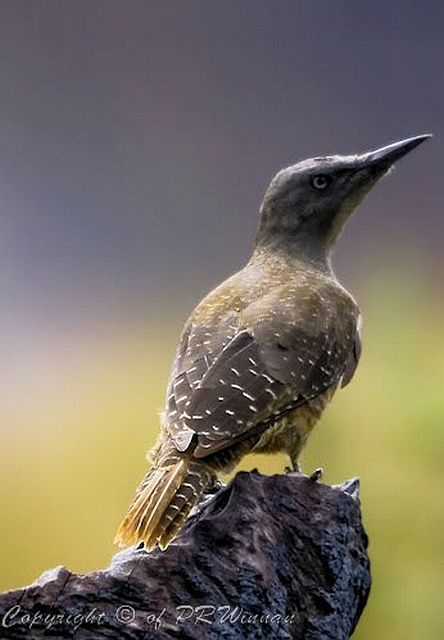 © Bushveld Jock
© Bushveld Jock
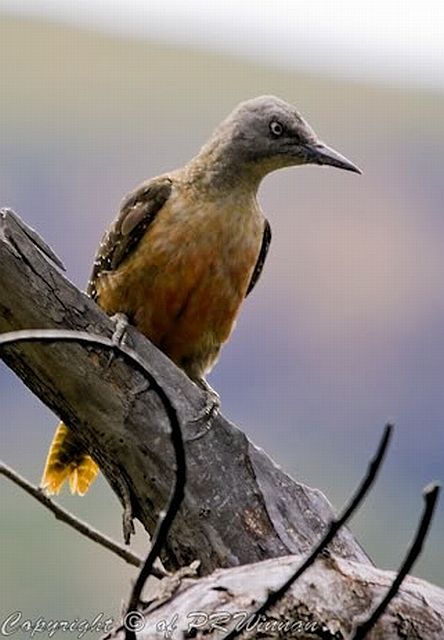 © Bushveld Jock
© Bushveld Jock
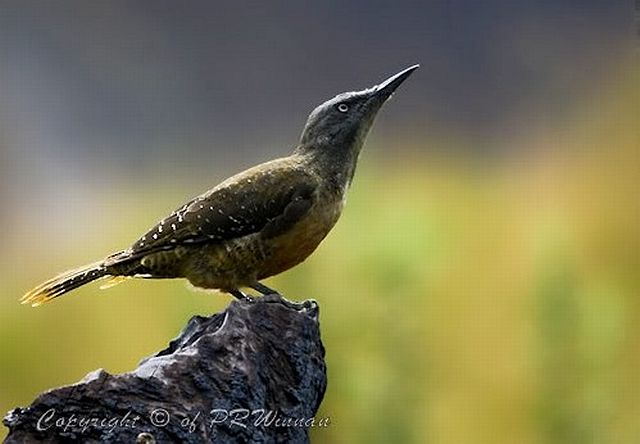 © Bushveld Jock
© Bushveld Jock
Links:
Species text Sabap1
Sabap2
NEWMAN'S VOELS VAN SA (8ste UIT)
 © Bushveld Jock
© Bushveld Jock © Bushveld Jock
© Bushveld Jock © Bushveld Jock
© Bushveld JockLinks:
Species text Sabap1
Sabap2
NEWMAN'S VOELS VAN SA (8ste UIT)
Kgalagadi: Dec 2015
KNP Maroela, Shingwedzi & Pretoriuskop: March 2016
KNP Maroela, Shingwedzi & Pretoriuskop: March 2016
Cardinal Woodpecker
486. Cardinal Woodpecker Dendropicos fuscescens (Kardinaalspeg)
Order: Piciformes. Family: Picidae
Description
The Cardinal Woodpecker has a height of 16 cm and is the smallest of the woodpecker species. Like other woodpeckers, it has a straight pointed bill, a stiff tail to provide support against tree trunks, and zygodactyl or “yoked" feet, with two toes pointing forward, and two backward. The long tongue can be darted forward to capture insects.
Conspicuously barred back and overall black and white appearance. It has a dull olive back, marked with white bars. The underparts are white, heavily streaked with black, and the rump is tawny. The white throat and face are separated by a conspicuous black malar stripe, and the forecrown is brown. Both sexes have a narrow black moustache. The bill is black. It has grey legs. The eyes are red to brown. The small crest is raised when the bird is excited.
Adult male: Forehead to mid-crown medium brown, hind crown and nape red; malar stripe blackish-brown. Lores, supercilium, ear coverts and throat white to greyish white, sparsely and finely streaked dark brown behind eye, on ear coverts and throat. Upper parts barred with alternating bands of blackish brown and white; tinged yellow or olive on rump and upper tail coverts. Tail brown with yellowish barring; shafts golden yellow. Underparts greyish white, thickly and densely streaked brownish black, tending to bars on lower flanks. Bill black, tongue long and with barbed tip. Eyes dark red-brown. Legs and feet greyish black.
The male has a scarlet red hind crown and nape, forehead and crown unmarked brown. (Heavily streaked cheeks and throat eliminate confusion with male Bennett's Woodpecker. Green-backed Woodpecker has red forecrown.)
The female has a dark hindcrown and black nape, and juvenile males have a red hindcrown and black nape.
Similar species: This species is not as green as Green-backed Woodpecker. The much larger Golden-tailed Woodpecker is the only other woodpecker in region with streaked underparts.
Distribution
Across most of Sub-Saharan Africa, excluding dense equatorial lowland forest. In Southern Africa native to Namibia, Botswana, Zimbabwe, South Africa, Lesotho and Swaziland.
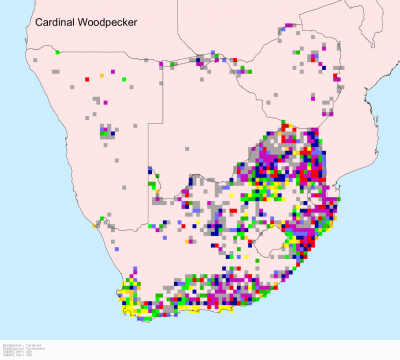
Habitat
It is most common in woodland and savanna, mainly found in light and densely wooded forests, where there are Mopane trees.
Diet
Like other woodpeckers, this species is an insectivore. It is an extremely agile forager, gleaning ants and termites from bark and leaves, breaking open seed pods and occasionally feeding on fruit.
Breeding
Monogamous. Both sexes excavate the nest, which is usually a hole in the underside of a tree branch, although nesting in wooden fence posts has also been recorded. Egg-laying season is from July-December, peaking from August-October. It lays 1-3 eggs, which are incubated by both sexes for about 12-13 days. The chicks are cared for by both parents, eventually leaving the nest after about 27 days. They become fully independent 1-2 months after fledging.
Parasitised by Scaly-throated Honeyguide and Lesser Honeyguide.
Call
The call is a high-pitched krrrek-krrrek-krrrek. Listen to Bird Call.
Status
Common resident. IUCN status - LC (Least Concern).
Order: Piciformes. Family: Picidae
Description
The Cardinal Woodpecker has a height of 16 cm and is the smallest of the woodpecker species. Like other woodpeckers, it has a straight pointed bill, a stiff tail to provide support against tree trunks, and zygodactyl or “yoked" feet, with two toes pointing forward, and two backward. The long tongue can be darted forward to capture insects.
Conspicuously barred back and overall black and white appearance. It has a dull olive back, marked with white bars. The underparts are white, heavily streaked with black, and the rump is tawny. The white throat and face are separated by a conspicuous black malar stripe, and the forecrown is brown. Both sexes have a narrow black moustache. The bill is black. It has grey legs. The eyes are red to brown. The small crest is raised when the bird is excited.
Adult male: Forehead to mid-crown medium brown, hind crown and nape red; malar stripe blackish-brown. Lores, supercilium, ear coverts and throat white to greyish white, sparsely and finely streaked dark brown behind eye, on ear coverts and throat. Upper parts barred with alternating bands of blackish brown and white; tinged yellow or olive on rump and upper tail coverts. Tail brown with yellowish barring; shafts golden yellow. Underparts greyish white, thickly and densely streaked brownish black, tending to bars on lower flanks. Bill black, tongue long and with barbed tip. Eyes dark red-brown. Legs and feet greyish black.
The male has a scarlet red hind crown and nape, forehead and crown unmarked brown. (Heavily streaked cheeks and throat eliminate confusion with male Bennett's Woodpecker. Green-backed Woodpecker has red forecrown.)
The female has a dark hindcrown and black nape, and juvenile males have a red hindcrown and black nape.
Similar species: This species is not as green as Green-backed Woodpecker. The much larger Golden-tailed Woodpecker is the only other woodpecker in region with streaked underparts.
Distribution
Across most of Sub-Saharan Africa, excluding dense equatorial lowland forest. In Southern Africa native to Namibia, Botswana, Zimbabwe, South Africa, Lesotho and Swaziland.

Habitat
It is most common in woodland and savanna, mainly found in light and densely wooded forests, where there are Mopane trees.
Diet
Like other woodpeckers, this species is an insectivore. It is an extremely agile forager, gleaning ants and termites from bark and leaves, breaking open seed pods and occasionally feeding on fruit.
Breeding
Monogamous. Both sexes excavate the nest, which is usually a hole in the underside of a tree branch, although nesting in wooden fence posts has also been recorded. Egg-laying season is from July-December, peaking from August-October. It lays 1-3 eggs, which are incubated by both sexes for about 12-13 days. The chicks are cared for by both parents, eventually leaving the nest after about 27 days. They become fully independent 1-2 months after fledging.
Parasitised by Scaly-throated Honeyguide and Lesser Honeyguide.
Call
The call is a high-pitched krrrek-krrrek-krrrek. Listen to Bird Call.
Status
Common resident. IUCN status - LC (Least Concern).
Cardinal Woodpecker Photos
486. Cardinal Woodpecker Dendropicos fuscescens
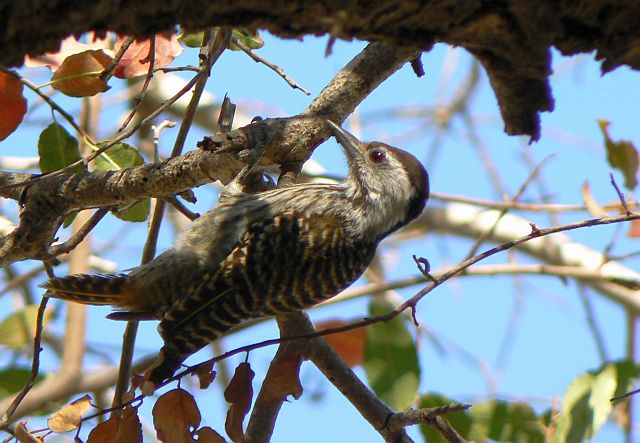 © Toko
© Toko
Female. Kruger National Park, Timbavati picinic spot.
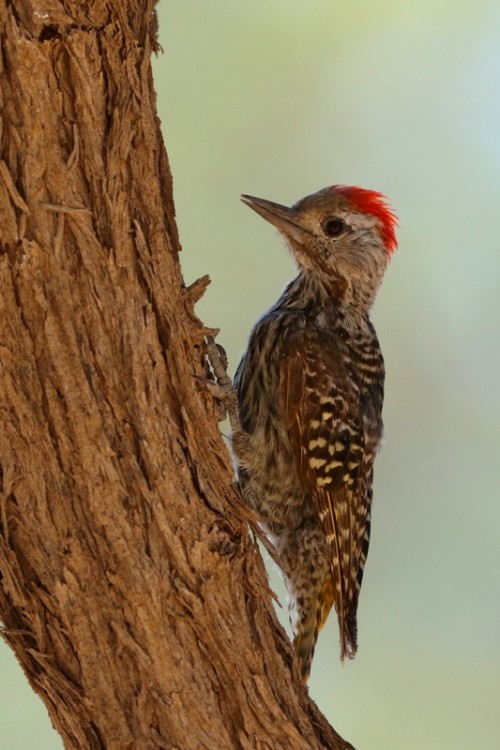 © Dindingwe
© Dindingwe
Male, Kgalagadi Transfrontier Park
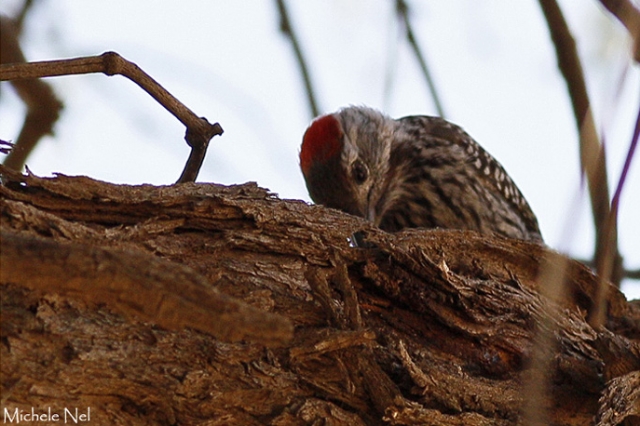 © Michele Nel
© Michele Nel
Male, Sesriem, Namibia
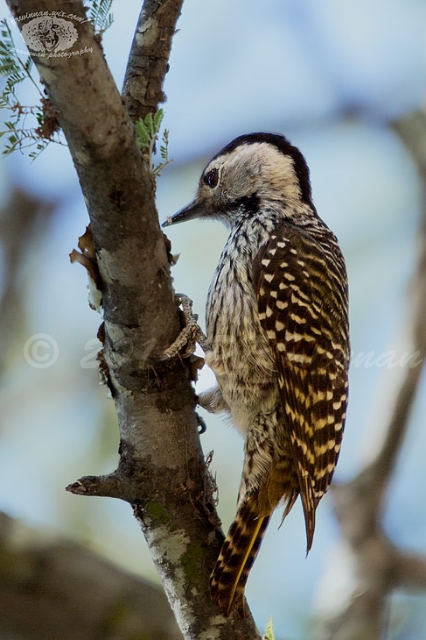 © PRWIN
© PRWIN
Female, Kruger National Park
 © Duke
© Duke
Male, Walter Sisulu National Botanical Gardens, Johannesburg
Links:
Sabap2
NEWMAN'S VOELS VAN SA (8ste UIT)
 © Toko
© TokoFemale. Kruger National Park, Timbavati picinic spot.
Male, Kgalagadi Transfrontier Park
 © Michele Nel
© Michele NelMale, Sesriem, Namibia
 © PRWIN
© PRWINFemale, Kruger National Park
 © Duke
© DukeMale, Walter Sisulu National Botanical Gardens, Johannesburg
Links:
Sabap2
NEWMAN'S VOELS VAN SA (8ste UIT)
- Amoli
- Posts: 6032
- Joined: Fri Jun 01, 2012 4:30 am
- Country: South Africa
- Location: Kempton Park
- Contact:
Bearded Woodpecker
487. Bearded Woodpecker Chloropicus namaquus (Baardspeg)
Order: Piciformes. Family: Picidae
Description
The Bearded Woodpecker is the largest of the arboreal woodpeckers found in the southern African region, with a length of about 24 cm and white facial markings are distinctive, the only woodpecker in the region that is barred on the breast and belly. A long-billed species with banded underparts and a bold black moustachial streak and ear-patch. The back and wings scalloped in buff. Underparts are very dark, grey, finely barred with white; cheeks and throat are white and they have a broad black malar stripe and black ear coverts. The bill is greyish-black; eyes are brownish-red; legs and feet are greyish-black. The sexes differ in their head markings.
The males crown is red, nape and hindneck black. Males are slightly larger than the females.
The female resembles the male, but the crown is black and flecked with white.
Juvenile more diffusely barred, both sexes with crown mixed red, black and white.
Distribution
It occurs from the Central African Republic to Senegal to South Africa, mostly absent from the DRC. In southern Africa it is fairly common in Mozambique, Zimbabwe, northern Namibia and north-eastern South Africa.

There are 3 subspecies:
C. n. schoensis: Ethiopia, Somalia and n Kenya
C. n. namaquus: Central African Republic to s Sudan, Kenya, Tanzania, n South Africa and n Namibia
C. n. coalescens: s Mozambique and e South Africa
Habitat
It dislikes dense forest, preferring deciduous woodland, thornveld, broad-leaved woodland, being most common in miombo (Brachystegia) and mopane (Colosphermum mopane).
Diet
It mainly forages in trees, tapping and probing branches in search of insects, licking them up with its barbed tongue. The following food items have been recorded in its diet: beetle larvae and pupae, Mopane emperor moth larvae, termite, spiders, lizards.
Breeding
Bearded Woodpeckers are monogamous. Both sexes excavate the nest, which is usually an oval-shaped hole in the trunk of a tree, although it has been recorded nesting in fence posts. Egg-laying season is from April-December, peaking from May-August. It lays 1-3 glossy-white eggs, which are incubated by both sexes for roughly 13 days. The chicks are cared for by both parents, leaving the nest at about 27 days old. The juveniles become fully independent roughly 1-2 months after fledging.
Call
A loud wik-wik-wik which increases in tempo as the call progresses. Listen to Bird Call. Loud drumming is characteristic and distinctive habit of this species. Loud fast drumming likely to be marking of territory.
Status
Common resident.
Order: Piciformes. Family: Picidae
Description
The Bearded Woodpecker is the largest of the arboreal woodpeckers found in the southern African region, with a length of about 24 cm and white facial markings are distinctive, the only woodpecker in the region that is barred on the breast and belly. A long-billed species with banded underparts and a bold black moustachial streak and ear-patch. The back and wings scalloped in buff. Underparts are very dark, grey, finely barred with white; cheeks and throat are white and they have a broad black malar stripe and black ear coverts. The bill is greyish-black; eyes are brownish-red; legs and feet are greyish-black. The sexes differ in their head markings.
The males crown is red, nape and hindneck black. Males are slightly larger than the females.
The female resembles the male, but the crown is black and flecked with white.
Juvenile more diffusely barred, both sexes with crown mixed red, black and white.
Distribution
It occurs from the Central African Republic to Senegal to South Africa, mostly absent from the DRC. In southern Africa it is fairly common in Mozambique, Zimbabwe, northern Namibia and north-eastern South Africa.

There are 3 subspecies:
C. n. schoensis: Ethiopia, Somalia and n Kenya
C. n. namaquus: Central African Republic to s Sudan, Kenya, Tanzania, n South Africa and n Namibia
C. n. coalescens: s Mozambique and e South Africa
Habitat
It dislikes dense forest, preferring deciduous woodland, thornveld, broad-leaved woodland, being most common in miombo (Brachystegia) and mopane (Colosphermum mopane).
Diet
It mainly forages in trees, tapping and probing branches in search of insects, licking them up with its barbed tongue. The following food items have been recorded in its diet: beetle larvae and pupae, Mopane emperor moth larvae, termite, spiders, lizards.
Breeding
Bearded Woodpeckers are monogamous. Both sexes excavate the nest, which is usually an oval-shaped hole in the trunk of a tree, although it has been recorded nesting in fence posts. Egg-laying season is from April-December, peaking from May-August. It lays 1-3 glossy-white eggs, which are incubated by both sexes for roughly 13 days. The chicks are cared for by both parents, leaving the nest at about 27 days old. The juveniles become fully independent roughly 1-2 months after fledging.
Call
A loud wik-wik-wik which increases in tempo as the call progresses. Listen to Bird Call. Loud drumming is characteristic and distinctive habit of this species. Loud fast drumming likely to be marking of territory.
Status
Common resident.
Pretoriuskop
Satara
Shingwedzi
20-30 Dec 2014
Satara
Shingwedzi
20-30 Dec 2014
- Amoli
- Posts: 6032
- Joined: Fri Jun 01, 2012 4:30 am
- Country: South Africa
- Location: Kempton Park
- Contact:
Bearded Woodpecker Photos
487. Bearded Woodpecker Chloropicus namaquus
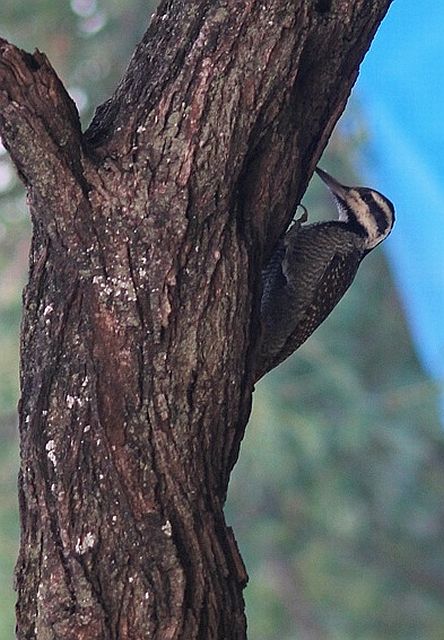 © Amoli
© Amoli
Male, Grietjie Private Reserve, Limpopo © Sprocky
 © Pumbaa
© Pumbaa
Female, Kruger National Park
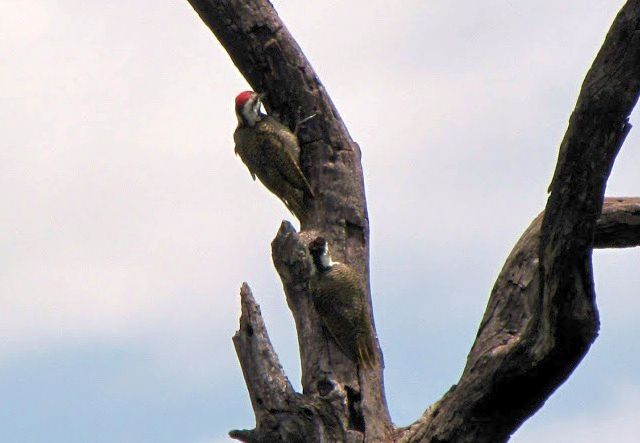 © Lisbeth
© Lisbeth
Male & Female
 © JustN@ture
© JustN@ture
Female
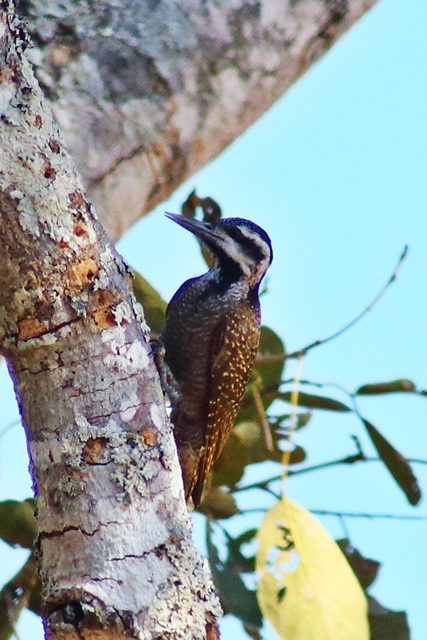 © Bush Brat
© Bush Brat
Kruger National Park, S83 Maroela Loop
Links:
Sabap2: http://sabap2.adu.org.za/species_info.p ... #menu_left
 © Amoli
© AmoliMale, Grietjie Private Reserve, Limpopo © Sprocky
 © Pumbaa
© PumbaaFemale, Kruger National Park
 © Lisbeth
© LisbethMale & Female
 © JustN@ture
© JustN@tureFemale
 © Bush Brat
© Bush BratKruger National Park, S83 Maroela Loop
Links:
Sabap2: http://sabap2.adu.org.za/species_info.p ... #menu_left
Pretoriuskop
Satara
Shingwedzi
20-30 Dec 2014
Satara
Shingwedzi
20-30 Dec 2014


